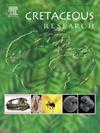Astrochronology of the terrestrial mid-Cretaceous Quantou and Denglouku formations in the SK-3 borehole from the Songliao Basin, Northeastern China
IF 1.7
3区 地球科学
Q1 GEOLOGY
引用次数: 0
Abstract
The continental scientific drilling borehole Songke 3 (SK-3) in the Songliao Basin, Northeastern China, recovers a continuous mid-Cretaceous stratigraphic record which offers a unique opportunity to study terrestrial climate and environmental change. In this study, high-resolution gamma-ray (GR) data were utilized as a paleoclimate proxy to conduct the cyclostratigraphic analysis of the Quantou Formation (K2q) and Denglouku Formation (K2d) within the SK-3 borehole. The cyclic variations in GR values, which reflect fluctuating clay influxes, document Cretaceous Milankovitch cycles including the 405-kyr long eccentricity, ∼100-kyr short eccentricity, ∼38-kyr obliquity, and ∼20-kyr precession cycles. Astronomical tuning of GR data series to the 405-kyr and 100-kyr eccentricity cycles yields an 8.89 ± 0.32 Myr duration for the K2d2 to K2q interval at SK-3. Based on the age of 91.81 ± 0.22 Ma at the boundary of Qingshankou (K2qn) and K2q formations derived from Songke 1 south borehole (SK-1s), our newly constructed astronomical time scale (ATS) suggests that the Turonian/Cenomanian and Cenomanian/Albian boundaries are at the depth ∼1055.5 m within the mid-K2q3 and ∼2350 m within the lower K2d2, respectively. Our study also indicates the complex processes of the sedimentary system in response to the Milankovitch cycles. The eccentricity cycles are more effectively preserved in the lacustrine-deltaic facies. In contrast, both obliquity and precession cycles exhibit better preservation in the meandering river and braided river facies.
松辽盆地SK-3井陆相中白垩统泉头组和登楼库组天体年代学
松辽盆地松科3号(SK-3)陆相科学钻孔恢复了连续的中白垩世地层记录,为研究陆相气候与环境变化提供了独特的机会。本文利用高分辨率伽玛射线(GR)资料作为古气候代用资料,对SK-3钻孔内泉头组(K2q)和登娄库组(K2d)进行了旋回地层分析。GR值的旋回变化反映了黏土流入的波动,记录了白垩纪Milankovitch旋回,包括405-kyr长偏心率、~ 100-kyr短偏心率、~ 38-kyr倾角和~ 20-kyr岁差旋回。将GR数据序列天文调谐到405-kyr和100-kyr的偏心周期,SK-3的K2d2至K2q区间的持续时间为8.89±0.32 Myr。根据松科1南钻孔(sk -1)青山口(K2qn)和K2q组边界的91.81±0.22 Ma年龄,我们新建立的天文时间尺度(ATS)表明,Turonian/Cenomanian和Cenomanian/Albian边界分别位于k2q3中部~ 1055.5 m和K2d2下部~ 2350 m深度。我们的研究还表明,沉积体系响应于米兰科维奇旋回的复杂过程。偏心率旋回在湖三角洲相中保存较好。曲流河相和辫状河相的倾角旋回和旋进旋回保存较好。
本文章由计算机程序翻译,如有差异,请以英文原文为准。
求助全文
约1分钟内获得全文
求助全文
来源期刊

Cretaceous Research
地学-地质学
CiteScore
4.10
自引率
19.00%
发文量
235
审稿时长
12 weeks
期刊介绍:
Cretaceous Research provides a forum for the rapid publication of research on all aspects of the Cretaceous Period, including its boundaries with the Jurassic and Palaeogene. Authoritative papers reporting detailed investigations of Cretaceous stratigraphy and palaeontology, studies of regional geology, and reviews of recently published books are complemented by short communications of significant new findings.
Papers submitted to Cretaceous Research should place the research in a broad context, with emphasis placed towards our better understanding of the Cretaceous, that are therefore of interest to the diverse, international readership of the journal. Full length papers that focus solely on a local theme or area will not be accepted for publication; authors of short communications are encouraged to discuss how their findings are of relevance to the Cretaceous on a broad scale.
Research Areas include:
• Regional geology
• Stratigraphy and palaeontology
• Palaeobiology
• Palaeobiogeography
• Palaeoceanography
• Palaeoclimatology
• Evolutionary Palaeoecology
• Geochronology
• Global events.
 求助内容:
求助内容: 应助结果提醒方式:
应助结果提醒方式:


